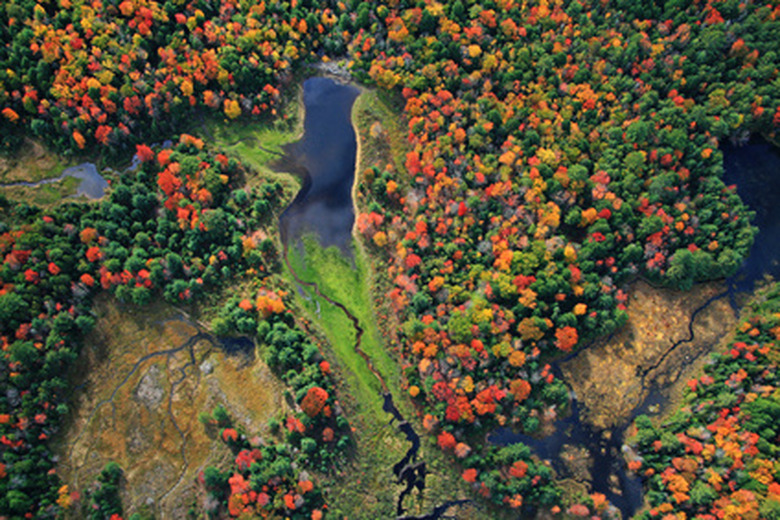Ecosystem Of Wetlands
Wetlands comprise areas that transition between terrestrial (land) areas and aquatic (water) areas. The wetlands ecosystem represents a richly diverse web of plants and animals interacting together. Wetlands ecosystems also exhibit great sensitivity to disturbance from outside influence, particularly by human development and environmental damage. Wetlands ecosystems provide the world with natural storm barriers, environmental cleansers, and food and water resources for many forms of life.
TL;DR (Too Long; Didn't Read)
Wetlands represent transitional areas between land and water. The balanced ecosystem of wetlands relies upon the interaction between living factors such as plants and animals and nonliving, abiotic factors.
What Is a Wetland?
What Is a Wetland?
Wetlands can be found throughout the world, in areas intersecting bodies of water and land. Their defining characteristic is the water they receive. A wetland can take many forms. Some types of wetlands include marshes, fens, bogs, riparian wetlands, swamps and estuaries. Wetlands that exist away from oceans obtain their water from ground water and precipitation; wetlands in coastal environments receive precipitation and ground water, but they are also affected by seawater and tides. In wetlands, the water table sits at or close to the surface of the land, and shallow water often covers the area. Some other characteristics of wetlands may include land supporting aquatic vegetation, a substrate of saturated soil and substrates not comprised of soil but inundated with water during the growing season. The water in wetlands ecosystems can be freshwater, saltwater, brackish water or flowing water. Wetlands contain wet soils and typically anaerobic environments, and rooted plants and other forms of life used to those conditions. While remaining distinct, the characteristics of wetlands may blend both terrestrial and aquatic environments.
Types of Wetlands
Types of Wetlands
Wetlands that contain rooted vegetation are considered emergent wetlands, and these include marshes and fens. Emergent wetlands include such plants as cattails, rushes and water lilies. In scrub-shrub wetlands, small saplings under 20 feet in height coincide with shrubs; flooding may be seasonal or permanent. One example of a scrub-shrub wetland is the bog, which contains peat mats that float away from the shore. The water of bogs tends toward higher acidity and lower oxygen levels, and it is not favorable for fish. Tall trees and their understory dominate forested wetlands such as swamps. Vernal pools represent temporary, shallow depressions formed from spring rains. When the water table reaches the surface, springs and seeps occur and provide another form of wetland important to plants and wildlife. Riparian wetlands comprise those areas alongside flowing waters such as streams and rivers; typically soils erode in such areas.
Abiotic Factors of Wetlands
Abiotic Factors of Wetlands
Abiotic factors in wetlands are nonliving factors affecting wetlands ecosystems. Wetlands abiotic factors include water itself and its varying sources, physiochemistry such as water and soil chemistry, hydrology or the affect of flooding and available oxygen. Weather is the abiotic factor that most prominently affects wetlands. In addition to precipitation, weather affects wetlands via storm winds and the currents made by them in larger bodies of water adjacent to wetlands. The affect of tides is another abiotic factor of wetlands. Topography and water level affects wetlands as well. Other abiotic factors of wetlands include sedimentation, erosion, turbidity (water clarity), nutrients, alkalinity, temperature and physical dynamics such as ice scouring in colder climates. Bedrock also features as a major abiotic factor of wetlands, as the underling substrate's chemistry directly affects the water and what kinds of species wetlands support. Climate itself hugely impacts wetlands. Another major abiotic factor is human intrusion via land use, agriculture, shipping and urban development.
Dominant Wildlife in Wetlands
Dominant Wildlife in Wetlands
Wetlands provide extraordinary wildlife diversity. The dominant wetlands wildlife includes fishes and crustaceans, migrating birds and waterfowl, and some mammal species such as:
- foxes
- minks
- deer
- even bears
Wetlands serve as spawning and nursery grounds for many fish. Turtles, frogs, snakes, and other reptiles and amphibians call wetlands home. Many of these animals provide food for other animals and for people. A number of endangered and threatened wildlife species reside in wetlands. Dominant wildlife in wetlands, whether they are birds, mammals, fish or invertebrates, rely upon the primary producers like aquatic vegetation to survive. The dominant wetlands wildlife species ensure food webs remain intact both near and far from wetlands.
Importance of Protecting Wetland Ecology
Importance of Protecting Wetland Ecology
Wetland ecology represents a balance between the species that live in wetlands and the environment around them. Hydrology affects every aspect of wetland ecology. Flooding shapes the chemical and physical characteristics of wetlands and how much oxygen exists in them. When this delicate balance unravels, wetlands and their denizens suffer. The world's wetlands have endured dramatic changes under the influence of human settlement, agriculture and its runoff, and industrial pollution. Pollution disrupts the chemical balance of wetlands that plants and animals depend upon to survive. Wetlands provide flood control, storm barriers, clean water and aquifer restoration. They also neutralize bacteria, absorb harmful chemicals and filter pollutants. Wetlands provide foods such as rice, fish, cranberries and other products with unparalleled economic importance. Scientists estimate at least 40 percent of the entire world's species resides in wetlands; without healthy wetlands ecosystems, many species on earth would suffer. Additionally, wetlands provide beauty and outdoor recreational activities for people to enjoy. Finding sustainable methods to conserve wetlands in an ever-changing world remains of paramount importance.
References
- The Nature Education Knowledge Project: Ecology of Wetland Ecosystems: Water, Substrate, and Life
- EPA's Web Archive: Great Lakes Coastal Wetlands: Abiotic and Floristic Characterization
- University of New Hampshire Extension: Wildlife Habitat Improvement: Wetlands and Wildlife
- World Wildlife Global: The Value of Wetlands
Cite This Article
MLA
Hermance, Dianne. "Ecosystem Of Wetlands" sciencing.com, https://www.sciencing.com/ecosystem-wetlands-6164461/. 22 November 2019.
APA
Hermance, Dianne. (2019, November 22). Ecosystem Of Wetlands. sciencing.com. Retrieved from https://www.sciencing.com/ecosystem-wetlands-6164461/
Chicago
Hermance, Dianne. Ecosystem Of Wetlands last modified August 30, 2022. https://www.sciencing.com/ecosystem-wetlands-6164461/
